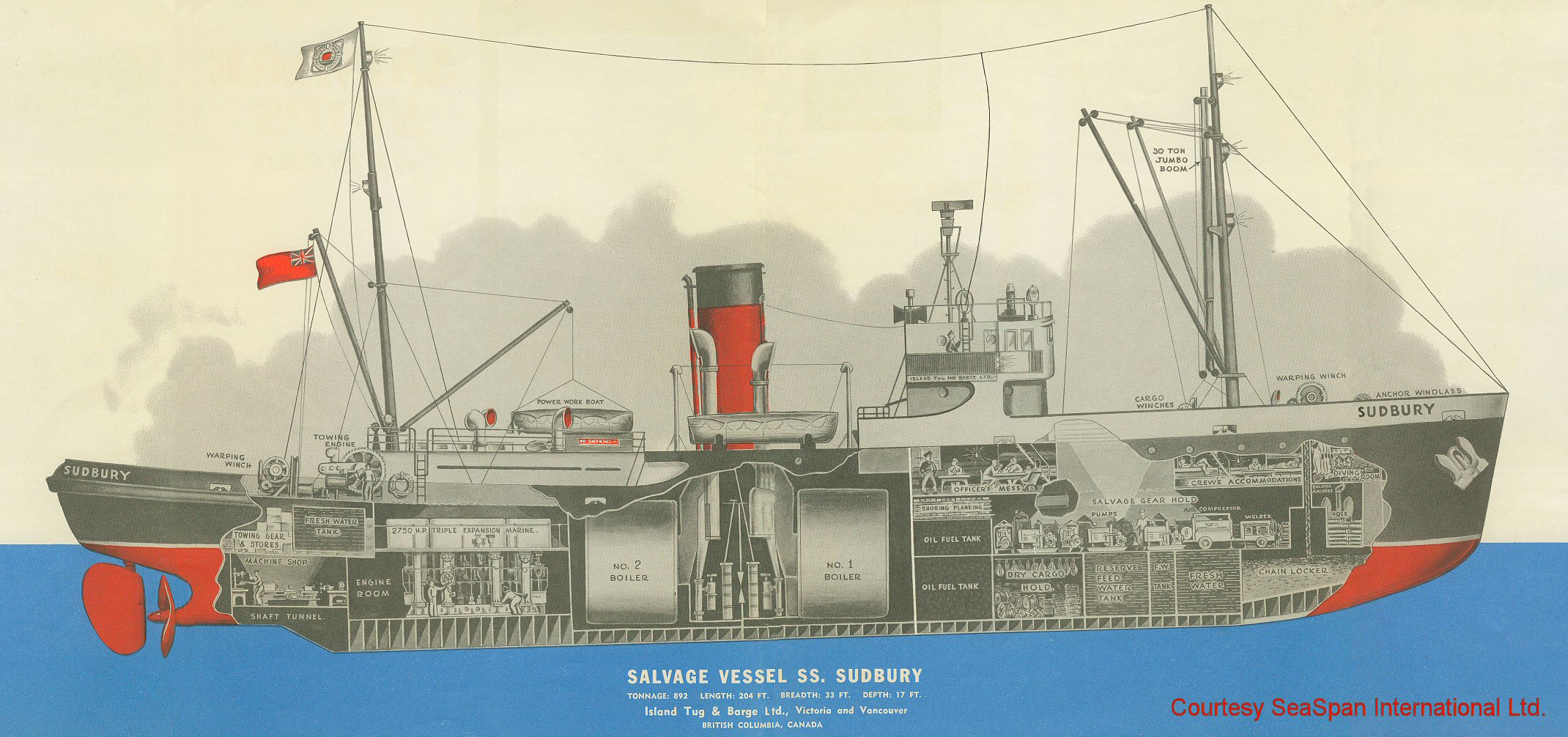To follow up on
my post from last week, I thought I would showcase a small portion of the operational history of the
Foundation Scarboro, a "derrick, compressor, and power boat of 230 tons lifting capacity".
 |
| Data sheet for Foundation Scarboro from a late-1950s rate schedule published by Foundation Maritime. |
Foundation Scarboro could be fitted with different lengths of shear legs, along with pontoons alongside the hull, to adjust her lifting capacity.
 |
| Foundation Scarboro under tow by the tug Glenlivet around January 6, 1932. Though bearing the Foundation "F" on her funnel, I can find no further information on the Glenlivet. |
The marine arm of the Foundation Company of Canada started off as a continuation of their shore-based construction business, and Foundation Scarboro ranged widely from the Great Lakes to the East Coast assisting in the construction of various projects, such as water intakes, wharves, and the like.
 |
| Foundation Scarboro lifting what appears to be some sort of water intake manifold, possibly in Toronto. |
 |
| Electrical switchboard, presumably onboard Foundation Scarboro. |
 |
| Lifting hook used by Foundation Scarboro. |
Foundation Scarboro herself would have been, if not the first, then one of the first assets of Foundation's new marine construction arm. Starting off as a barge with two shear legs capable of lifting up to 263 tons (assuming 40-foot shear legs and pontoons were fitted), she needed a tug to get her from one location to the next. Some time before 1935, she was fitted with an electric revolving derrick crane of 25-ton capacity for greater flexibility with smaller loads.
In December 1935, Foundation Scarboro was in Saint John, New Brunswick, handling concrete cylinders 9' in diameter.
 |
| Foundation Scarboro handling a concrete cylinder in Saint John. I'm guessing the cylinder was pre-cast within the graving dock, which was then flooded so that Scarboro could pick it up, deliver, and install it. She has pontoons installed to increase her lifting capacity. |
 |
| A close-up of the "equalizer" that was used to allow both shear legs to share the load of the concrete cylinders. |
 |
| Foundation Scarboro, now with the rotating crane derrick installed, is shown placing a 9' diameter concrete cylinder. The tug alongside does not seem to belong to the Foundation fleet. |
 |
| Placing a concrete cylinder in Saint John. |
In September 1945, Foundation Scarboro was back to help dismantle Berths 1, 2, 3, and 4 in West Saint John, possibly in preparation for a new immigration and customs facility. The EGM Company of Montreal
was awarded a contract to prepare the site, and I wonder if the Foundation Company of Canada received a sub-contract for the marine work.
 |
| Foundation Scarboro in drydock, presumably in Saint John, NB. |
 |
| From the looks of the scaffolding around the top of the shear legs and around the pontoon alongside the hull, it would appear that Foundation Scarboro is receiving some maintenance work. |
Foundation Scarboro was also dragged into Foundation Maritime's salvage business at times. In at least one instance, it was to salvage one of their own: as told in Farley Mowat's
Grey Seas Under (p. 171-172
), Foundation Maritime frantically purchased any tug still afloat that they could get their hands on at the beginning of the Second World War, and many were in fragile condition - in the case of the J
ohn G. Chandler, she was rammed at her berth in Halifax in late 1940, raised, and sank again.
Foundation Scarboro raised her, and a number of these unfortunate vessels ended up beached on McNab's Island - the
Chandler possibly among them.
Note: I've since discovered the entry for the
John G. Chandler in the
NS wreck database, and it indicates that she sunk on December 10, 1940, after a collision with
Foundation Jupiter.
Additional Note: Mac Mackay of
Shipfax was able to fill in some of the missing information here. He writes: "
JOHN G. CHANDLER was built in 1902 in Bath, Maine and arrived in Halifax for the first time that I can determine, in August 1940. FM was so desperate for tugs they bought whatever they could find. On November 10, 1940 it sank at the dock. It was raised January 1, 1940 and was being towed to Mill Cove for drydocking (I guess there was a slipway there) but it began to sink again, so was towed back to the Foundation dock where it fell over on its side and filled with water.".
 |
| Raising the John G. Chandler. |
 |
| Raising the John G. Chandler. |
In 1943, Foundation Scarboro raised the wreck of the lightship Red Island in Halifax Harbour (I am currently unable uncover further information about this ship).
 |
| Raising the Red Island. Roy Tidman photo, Halifax Chronicle and Daily Star. |
Foundation Scarboro seems to have remained in service for quite some time. In a company publication from the early 1960s (it shows the "newly purchased" salvage vessel Foundation Venture, which was purchased in 1961), Foundation Scarboro was still shown as part of the Foundation Maritime fleet.

































































